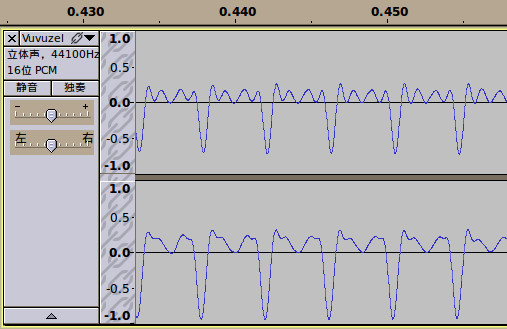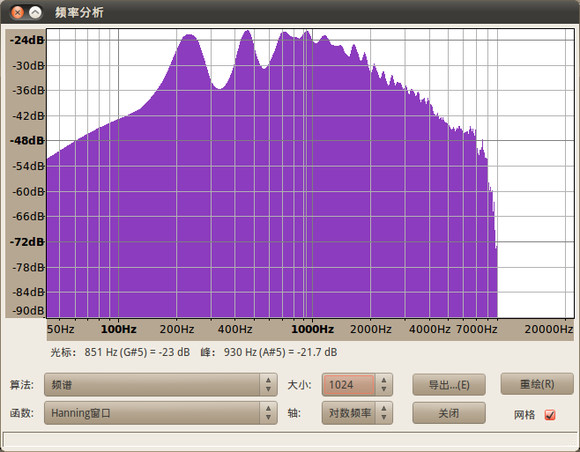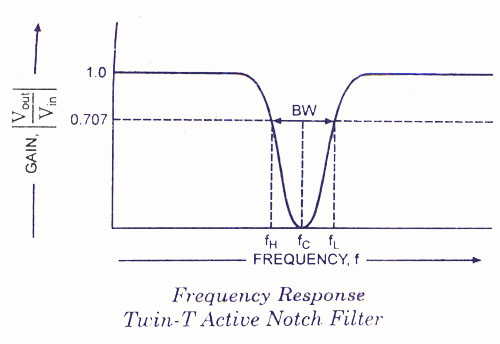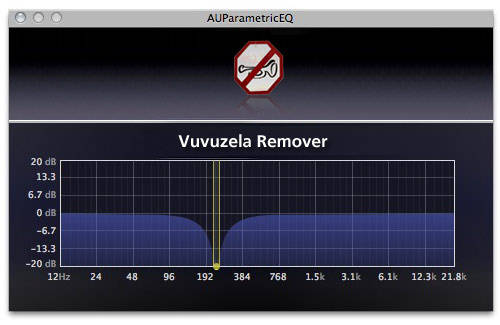(New page: '''Composed by Chen Chen''' You may still remember the Vuvuzelas during the South Africa, which is horribly annoying. Unfortunately nearly 98% of the Vuvuzelas are made in China with very ...) |
|||
| Line 1: | Line 1: | ||
'''Composed by Chen Chen''' | '''Composed by Chen Chen''' | ||
| + | |||
You may still remember the Vuvuzelas during the South Africa, which is horribly annoying. | You may still remember the Vuvuzelas during the South Africa, which is horribly annoying. | ||
| + | |||
Unfortunately nearly 98% of the Vuvuzelas are made in China with very low prices and resulting in huge disturbance to the game, I feel strong obligated to design a filter to remove the noise. | Unfortunately nearly 98% of the Vuvuzelas are made in China with very low prices and resulting in huge disturbance to the game, I feel strong obligated to design a filter to remove the noise. | ||
Analysis: | Analysis: | ||
| + | |||
There are 3 major sound components of a soccer game on TV: | There are 3 major sound components of a soccer game on TV: | ||
| + | |||
1. Game commentator's voice | 1. Game commentator's voice | ||
| + | |||
2. Game background sounds: audience cheering, referee whistle, coach and players yelling ( which give you sound-surround ambiance) | 2. Game background sounds: audience cheering, referee whistle, coach and players yelling ( which give you sound-surround ambiance) | ||
| + | |||
3. Vuvuzelas noise | 3. Vuvuzelas noise | ||
| + | |||
Frequency analysis: | Frequency analysis: | ||
| + | |||
The frequency analysis shows that human voice range is approximately 80Hz-700Hz. | The frequency analysis shows that human voice range is approximately 80Hz-700Hz. | ||
| + | |||
The frequency of Vuvuzelas needs more effort to analysis. | The frequency of Vuvuzelas needs more effort to analysis. | ||
| + | |||
There are multiple plots of frequency analysis of Vuvuzelas: | There are multiple plots of frequency analysis of Vuvuzelas: | ||
[[Image:Vuvuzelas.jpg]] | [[Image:Vuvuzelas.jpg]] | ||
| + | |||
This is the separated waveform plot of Vuvuzelas, showing that it is periodic. Which is very convenient to implement DSP methods using Fourier transform. | This is the separated waveform plot of Vuvuzelas, showing that it is periodic. Which is very convenient to implement DSP methods using Fourier transform. | ||
| + | |||
Further exploration of the waveform, the dB plot is as following: | Further exploration of the waveform, the dB plot is as following: | ||
[[Image:Vuvu2.jpg]] | [[Image:Vuvu2.jpg]] | ||
| + | |||
This is dB plot of Vuvuzelas sound. | This is dB plot of Vuvuzelas sound. | ||
| + | |||
In the plots, the frequency range is from 50Hz to 7000Hz, but there are several dominant formants at 192Hz 233Hz 466Hz 932Hz and 1864Hz | In the plots, the frequency range is from 50Hz to 7000Hz, but there are several dominant formants at 192Hz 233Hz 466Hz 932Hz and 1864Hz | ||
Design: | Design: | ||
| + | |||
In order to remove the noise from Vuvuzelas, we need to implement a couple of high frequency band-stop filters. | In order to remove the noise from Vuvuzelas, we need to implement a couple of high frequency band-stop filters. | ||
| + | |||
Each filter is used to remove corresponding frequency component. | Each filter is used to remove corresponding frequency component. | ||
| + | |||
Notch filter is an ideal band-stop filter with a narrow stopband (high Q factor) which are used in live sound reproduction. | Notch filter is an ideal band-stop filter with a narrow stopband (high Q factor) which are used in live sound reproduction. | ||
[[Image:Bandstop.jpg]] | [[Image:Bandstop.jpg]] | ||
| + | |||
This is the frequency response of a notch filter | This is the frequency response of a notch filter | ||
| Line 30: | Line 48: | ||
The audio signal will go through the filters connected in series and the output will be a much better audio signal with Vuvuzelas noise greatly reduced. | The audio signal will go through the filters connected in series and the output will be a much better audio signal with Vuvuzelas noise greatly reduced. | ||
[[Image:Notch.jpg]] | [[Image:Notch.jpg]] | ||
| + | |||
This is the frequency response of audio signal after notch filter with stop band around 192Hz | This is the frequency response of audio signal after notch filter with stop band around 192Hz | ||
| + | |||
From previous plot, we can see, that the 192Hz component is greatly reduced. | From previous plot, we can see, that the 192Hz component is greatly reduced. | ||
| + | |||
Also, additional filter which enhance the frequency components for 80-700Hz except 192Hz 233Hz and 466Hz,will give better filtered game sound. | Also, additional filter which enhance the frequency components for 80-700Hz except 192Hz 233Hz and 466Hz,will give better filtered game sound. | ||
| + | |||
'''Composed by Chen Chen.''' | '''Composed by Chen Chen.''' | ||
Revision as of 01:23, 5 December 2010
Composed by Chen Chen
You may still remember the Vuvuzelas during the South Africa, which is horribly annoying.
Unfortunately nearly 98% of the Vuvuzelas are made in China with very low prices and resulting in huge disturbance to the game, I feel strong obligated to design a filter to remove the noise.
Analysis:
There are 3 major sound components of a soccer game on TV:
1. Game commentator's voice
2. Game background sounds: audience cheering, referee whistle, coach and players yelling ( which give you sound-surround ambiance)
3. Vuvuzelas noise
Frequency analysis:
The frequency analysis shows that human voice range is approximately 80Hz-700Hz.
The frequency of Vuvuzelas needs more effort to analysis.
There are multiple plots of frequency analysis of Vuvuzelas:

This is the separated waveform plot of Vuvuzelas, showing that it is periodic. Which is very convenient to implement DSP methods using Fourier transform.
Further exploration of the waveform, the dB plot is as following:

This is dB plot of Vuvuzelas sound.
In the plots, the frequency range is from 50Hz to 7000Hz, but there are several dominant formants at 192Hz 233Hz 466Hz 932Hz and 1864Hz
Design:
In order to remove the noise from Vuvuzelas, we need to implement a couple of high frequency band-stop filters.
Each filter is used to remove corresponding frequency component.
Notch filter is an ideal band-stop filter with a narrow stopband (high Q factor) which are used in live sound reproduction.

This is the frequency response of a notch filter
By varying the Q parameter of notch filter, it is possible to design notch filter with narrow stop bands around192Hz 233Hz 466Hz 932Hz and 1864Hz.
The audio signal will go through the filters connected in series and the output will be a much better audio signal with Vuvuzelas noise greatly reduced.

This is the frequency response of audio signal after notch filter with stop band around 192Hz
From previous plot, we can see, that the 192Hz component is greatly reduced.
Also, additional filter which enhance the frequency components for 80-700Hz except 192Hz 233Hz and 466Hz,will give better filtered game sound.
Composed by Chen Chen.
Reference http://goodog.uueasy.com/read-htm-tid-3343.html http://www.yangtse.com/news/ty/201006/t20100618_743429.htm http://www.answers.com/topic/band-stop-filter http://en.wikipedia.org/wiki/Band-stop_filter

